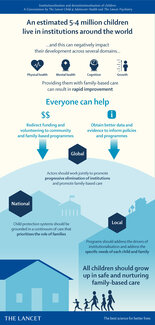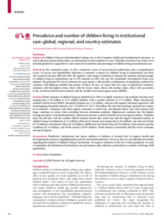Summary
Background
Children living in institutionalised settings are at risk of negative health and developmental outcomes, as well as physical and emotional abuse, yet information on their numbers is scarce. Therefore, the aim of our study was to estimate global-level, regional-level, and country-level numbers and percentages of children living in institutional care.
Methods
In this estimation study, we did a systematic review of peer-reviewed publications and a comprehensive review of surveys and unpublished literature to construct a dataset on children living in institutional care from 136 countries between 2001 and 2018. We applied a wide range of methods to estimate the number and percentages of children living in institutional care in 191 countries in 2015, the year the Sustainable Development Goals were adopted. We generated 98 sets of estimates for each dataset, with possible combinations of imputation methods for countries with different available data points. Of these 98 sets, we report here five types of global-level estimates: estimates with the highest values, those with the lowest values, those with median values, those with uncertainty levels, and those derived from methods with the smallest root-mean-square errors (RMSE).
Findings
Global estimates of children living in institutions in 2015 was highly sensitive to the methods and data used, ranging from 3·18 million to 9·42 million children, with a median estimate of 5·37 million. When selecting the method with the lowest RMSE, the global estimate was 4·21 million, whereas with negative binomial regression with bootstrapping, the global estimate was 7·52 (95% CI 7·48–7·56) million. We also observed large variations in country-level estimates. Compared with other regions, estimates in south Asia, sub-Saharan Africa, and Latin America had larger variations in values when switching between estimation methods. High-income countries had the highest average prevalence of institutionalisation, whereas low-income countries had the lowest average prevalence. Estimates from the full data with the smallest RMSE method showed that south Asia had the largest estimated number of children living in institutions (1·13 million), followed by Europe and central Asia (1·01 million), east Asia and Pacific (0·78 million), sub-Saharan Africa (0·65 million), Middle East and North Africa (0·30 million), Latin America and the Caribbean (0·23 million), and North America (0·09 million). North America consistently had the lowest estimates among all regions.
Interpretation
Worldwide, institutional care places millions of children at elevated risk of negative health and developmental outcomes, highlighting the need for deinstitutionalisation. However, there is considerable uncertainty regarding the number of children living in institutions. To improve estimates of the size of this population, we need to standardise the definition of institutional care and improve data collection, particularly in countries with large child populations.
Read the accompanying comment piece here.
Related:
- Institutionalisation and deinstitutionalisation of children: the Executive Summary from a Lancet Group Commission
- Institutionalisation and deinstitutionalisation of children 1: a systematic and integrative review of evidence regarding effects on development
- Institutionalisation and deinstitutionalisation of children 2: policy and practice recommendations for global, national, and local actors
- Global prevalence of institutional care for children: a call for change


